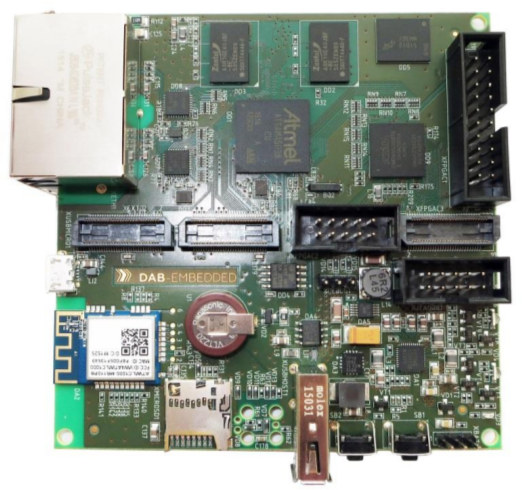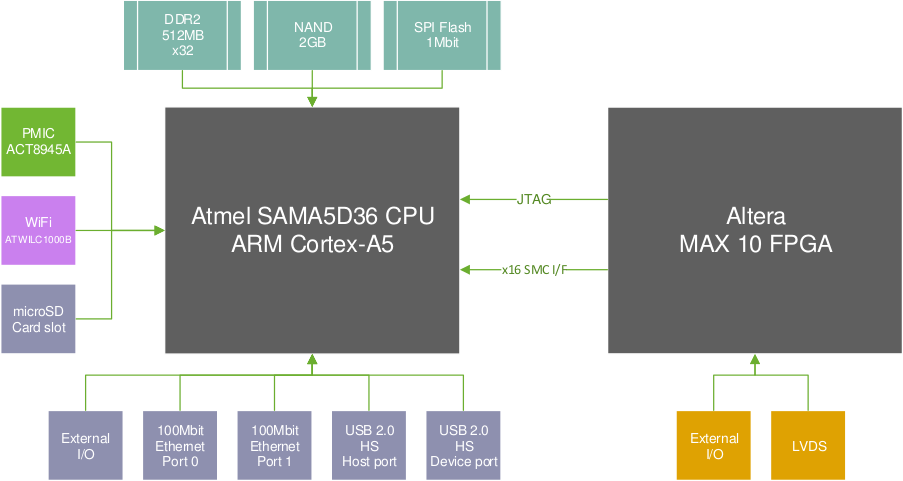DAB Embedded, a Belgian engineering company specialized in research and development of electronic products, has designed DAB-OWT-SAM5 router board powered by Atmel SAMA5D36 Cortex-A5 processor and Altera MAX 10 FPGA, which runs OpenWrt or Windows Embedded Compact 7, and targets IoT applications.

DAB-OWT-SAM5 board specifications:
- SoC – Atmel SAMA5D36 ARM Cortex-A5 processor @ 536MHz with Floating-Point Unit.
- FPGA – Altera MAX 10 FPGA with integrated ADC (Exact part number not disclosed)
- System Memory – Up to 512MB DDR2
- Storage – Up to 2GB NAND flash, 1Mbit SPI flash, micro SD slot
- Connectivity – 2x Fast Ethernet ports, 802.11 b/g/n WiFi (Direct, station mode, and soft-AP) via Atmel ATWILC1000B module
- Display Interface – LVDS connected to FPGA
- USB – 1x USB 2.0 host, 1x USB 2.0 device
- Expansion Connectors
- Wired interfaces – RS232, CAN 2.0 A/B, KNX, RS-485/422, etc…
- Wireless connectivity – Zigbee, Z-Wave, KNX RF, etc…
- Power Supply – 5V DC power supply, external Li+ battery
- Dimensions – N/A

The company can provide OpenWrt firmware with Linux 4.1 BSP, and/or Windows Embedded Compact 7, and NIOS II examples for the FPGA.
DAB Embedded did not release availability nor pricing information. A few more details may be available on DAB-OWT-SAM5 product page.

Jean-Luc started CNX Software in 2010 as a part-time endeavor, before quitting his job as a software engineering manager, and starting to write daily news, and reviews full time later in 2011.
Support CNX Software! Donate via cryptocurrencies, become a Patron on Patreon, or purchase goods on Amazon or Aliexpress





Calling that a router is really a disservice, as it’s not going to do a particularly good job as a router. A developer platform for IoT applications, maybe, but it seems to support a poor choice of OSes for that, as OpenWRT requires a lot of work to support things like Z-Wave and ZigBee and I’m talking from past experience here.
Don’t really understand why they chose the WILC1000 as the Wi-Fi chip. The kernel driver is still staging, for good reason. Atmel’s own driver is not particularly great either.
This board is using not as “big router”, but as IoT router for Embedded purposes. Main OS is Linux (with OpenWRT).
We support ZM5202 module (Z-Wave) for this router.
WILC1000 is good basic solution for WiFi, because it shows minimal power consumtion when it works. We did not see any serious problem with driveers, it works perfect with OpenWRT image.
What’s the FPGA meant for? Extra I/O to blink LEDs?
We have firmware example, where NIOS II core is working on FPGA. You can put 10 additional UART ports in FPGA and control it from SAMA5D3, or you can put 8x Audio I2S channels in FPGA and make presampling in FPGA.
Now is it possible to soder up to 16000 Logic Elements/Cells MAX10 FPGA (10M16SCU169I7G or 10M16SAU169I7G).
Or you can put 3x CAN 2.0 B bus controllers in FPGA with NIOS II for CANopen implementation.
@Jon
You can find 6 LVDS pairs on XFPGAC1 connector, 5x analog inputs on XFPGAC2 connector, 20 FPGA I/O on XFPGAC3